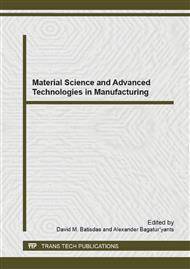p.81
p.86
p.92
p.96
p.101
p.106
p.111
p.117
p.121
Preparation and Microstructure of Exfoliated Graphite with Large Expanding Volume by Two-Step Intercalation
Abstract:
Exfoliated graphite with large expanding volume (EV) was prepared by two-step intercalation, in which the mixture of nitric acid and phosphoric acid, and that of nitric acid and acetic acid were employed as intercalating agent step by step, and potassium permanganate was used as oxidant. Its preparation conditions were optimized by orthogonal experiment and parallel experiment, and its microstructure was analyzed by scanning electron microscope. The results show that the optimal preparation conditions for the first step intercalation are as follows: the mass-volume ratio of natural graphite (NG) to mixed acid is 1: 4, the volume ratio of nitric acid to phosphoric acid is 1: 2, the mass ratio of NG to potassium permanganate is 1: 0.2, and the reaction temperature is 20~30°C for 40~60 minutes. Those for the second step intercalation are as follows: the mass-volume ratio of acidized graphite (AG) to acetic acid is 1: 5, the mass-volume ratio of AG to nitric acid is 1: 1.5, the mass ratio of AG to potassium permanganate is 1: 0.15, and the reaction temperature is 20~30°C for 40~60 minutes, the EV is 450ml/g under the conditions listed above. The interlayers of graphite are fully opened and become a worm-like fluffy rope.
Info:
Periodical:
Pages:
101-105
Citation:
Online since:
January 2014
Authors:
Price:
Сopyright:
© 2014 Trans Tech Publications Ltd. All Rights Reserved
Share:
Citation:


